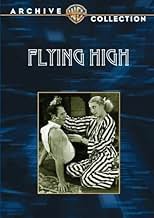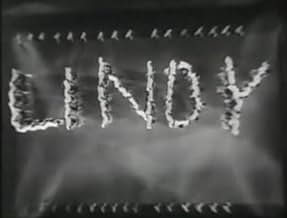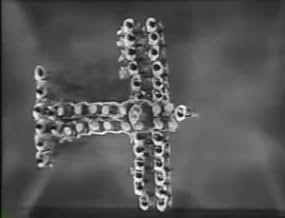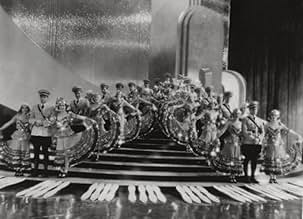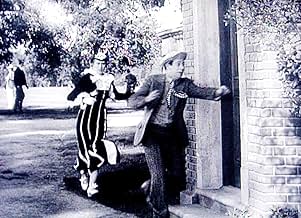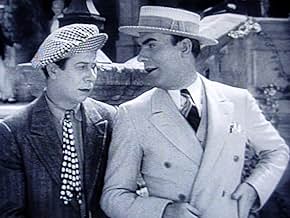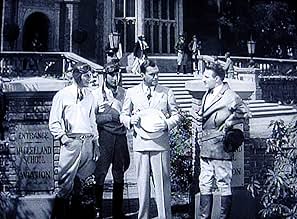Agrega una trama en tu idiomaAn eccentric inventor and his new flying machine are the focus of this musical comedy.An eccentric inventor and his new flying machine are the focus of this musical comedy.An eccentric inventor and his new flying machine are the focus of this musical comedy.
- Dirección
- Guionistas
- Elenco
- Premios
- 1 premio ganado en total
Gus Arnheim and His Orchestra
- Gus ArnHeim's Orchestra
- (as Gus Arnheim and his Orchestra)
Loretta Andrews
- Chorus Girl
- (sin créditos)
Mary Ashcraft
- Chorus Girl
- (sin créditos)
Edna Callahan
- Chorus Girl
- (sin créditos)
Richard Carle
- Hotel Manager
- (sin créditos)
Tommy Conlon
- Undetermined Secondary Role
- (sin créditos)
Nick Copeland
- Aviator with the Jokester
- (sin créditos)
Janet Currie
- Chorus Girl
- (sin créditos)
Mary Dees
- Chorus Girl
- (sin créditos)
Opiniones destacadas
This seems like an opened-out play. The opening out is fine. There are some highly entertaining Busby Berkeley dance routines and Pat O'Brien is always fun.
Bert Lahr is an acquired taste never acquired by me. But Charlotte Greenwood is utterly delightful in this, as the spinster who sets her sights on him as her last best chance for marriage.
Her physical, somewhat self-mocking comedy is a precuser to that of Joan Davis a decade of so later. Both are treasures.
Bert Lahr is an acquired taste never acquired by me. But Charlotte Greenwood is utterly delightful in this, as the spinster who sets her sights on him as her last best chance for marriage.
Her physical, somewhat self-mocking comedy is a precuser to that of Joan Davis a decade of so later. Both are treasures.
This is the rarest of beasts - a musical comedy film from 1931. Hardly any were made in either 1931 and 1932 due to the bad reputation the earliest musicals had earned in 1929 and 1930. However, almost all of the American musical films made in 1931 and 1932 featured the choreography of Busby Berkeley, and indeed this one does too.
Pat O'Brien is the best known of the three stars here, but he basically plays a supporting role in this one, prior to his recruitment by Warner Bros. first as a smart guy in the precode era and then as a father figure after the code. Sport Wardall (O'Brien) rescues Rusty Krouse (Lahr) from a group of bullies. The two team up with Wardall looking for financial backing for Rusty's aerocopter, a flying machine that ascends straight up. Ultimately Wardall finds backing from homely but man-hungry waitress Pansy Potts (the lanky Charlotte Greenwood). Her fee for the needed five hundred dollars - marriage to Rusty sight unseen.
If you've seen Greenwood chasing Buster Keaton in "Parlor, Bedroom, and Bath" or Eddie Cantor in "Palmy Days" you've seen this act before, but it's always funny. What must have seemed very odd to the audiences of 1931 was Lahr's brand of humor. Here he is carrying on just exactly like the cowardly lion in "Wizard of Oz" right down to his voice and mannerisms, so modern audiences will probably not be put off by his performance since most people today are familiar with Lahr in that part.
I rate this 4/5 for fans of the early talkies and precodes, but if you are a modern film fan you just might not appreciate this one that much.
Pat O'Brien is the best known of the three stars here, but he basically plays a supporting role in this one, prior to his recruitment by Warner Bros. first as a smart guy in the precode era and then as a father figure after the code. Sport Wardall (O'Brien) rescues Rusty Krouse (Lahr) from a group of bullies. The two team up with Wardall looking for financial backing for Rusty's aerocopter, a flying machine that ascends straight up. Ultimately Wardall finds backing from homely but man-hungry waitress Pansy Potts (the lanky Charlotte Greenwood). Her fee for the needed five hundred dollars - marriage to Rusty sight unseen.
If you've seen Greenwood chasing Buster Keaton in "Parlor, Bedroom, and Bath" or Eddie Cantor in "Palmy Days" you've seen this act before, but it's always funny. What must have seemed very odd to the audiences of 1931 was Lahr's brand of humor. Here he is carrying on just exactly like the cowardly lion in "Wizard of Oz" right down to his voice and mannerisms, so modern audiences will probably not be put off by his performance since most people today are familiar with Lahr in that part.
I rate this 4/5 for fans of the early talkies and precodes, but if you are a modern film fan you just might not appreciate this one that much.
I saw this picture once,ages ago. Lahr is a cuckoo inventor who is trying to gain interest in his new type of dirigible(a method which became obsolete in a few years anyway). And he has to dodge spinster Charlotte Greenwood, who relentlessly pursues him and who Lahr sneeringly calls "that Giraffe".
Not that Lahr looks like a matinee idol himself, and that was part of t he problem.
While Lahr was under contract to MGM for a few years,when Red Skelton came along in the early 1940's they decided to cast their lot with Red(not a bad move). And Lahr was a dyed-in-the-wool New Yorker who preferred to make his living on the Broadway stage and shared Fred Allen's famous opinion that "California is a great place to live if you're an orange".
Lahr never played a lead role again---he was inserted as 3rd or 4th bill comedy relief in all of his best remembered films--the last one being ROSE MARIE(1954).
Not that Lahr looks like a matinee idol himself, and that was part of t he problem.
While Lahr was under contract to MGM for a few years,when Red Skelton came along in the early 1940's they decided to cast their lot with Red(not a bad move). And Lahr was a dyed-in-the-wool New Yorker who preferred to make his living on the Broadway stage and shared Fred Allen's famous opinion that "California is a great place to live if you're an orange".
Lahr never played a lead role again---he was inserted as 3rd or 4th bill comedy relief in all of his best remembered films--the last one being ROSE MARIE(1954).
I have not seen FLYING HIGH yet, so no opinion there, but wanted to respond to Lonesome Prospector's ridiculous and ignorant speculation that Bert Lahr could be copying Curly Howard. Just because you saw Curly first doesn't mean he came first.
Bert Lahr began his performing career in 1910. He worked in vaudeville for 17 years, before making his Broadway debut in 1927. According to his biographer (and son) John Lahr, Bert Lahr had established his "gnong gnong" sound before 1920, as he is working it into his cop-and-dancer vaudeville act with his then-wife in the late teens and early 20's.
Curly Howard had not thought about being a performer until 1932, when brother Samuel (Shemp) left Ted Healy's Stooges, and brother Moe asked little brother Jerry (Curly) to join. At this time, Bert Lahr had already made his feature film debut, and was midway through a career as a Broadway headliner. The Stooges were scrambling through various short subject departments until they wound up at Columbia in 1934. A careful observation of their development shows that Curly had not really set his "schtick" until 1934 or 1935.
You might not think he was a big deal because he made few successful movies, but dollar for dollar Bert Lahr was a much, much bigger star than Curly Howard. Moreover, at the conclusion of his career he performed in the American premiere of WAITING FOR GODOT, did Shakespeare. Aristophanes and Feydeau. Not to say that Curly Howard couldn't have done such things, but he was long dead of a stroke, perhaps precipitated by the years of beatings he'd received from his fellow stooges.
FLYING HIGH might not be much cinematically, but it is priceless artifact of theater history, preserving Lahr as he appeared on stage in his early peak years.
Bert Lahr began his performing career in 1910. He worked in vaudeville for 17 years, before making his Broadway debut in 1927. According to his biographer (and son) John Lahr, Bert Lahr had established his "gnong gnong" sound before 1920, as he is working it into his cop-and-dancer vaudeville act with his then-wife in the late teens and early 20's.
Curly Howard had not thought about being a performer until 1932, when brother Samuel (Shemp) left Ted Healy's Stooges, and brother Moe asked little brother Jerry (Curly) to join. At this time, Bert Lahr had already made his feature film debut, and was midway through a career as a Broadway headliner. The Stooges were scrambling through various short subject departments until they wound up at Columbia in 1934. A careful observation of their development shows that Curly had not really set his "schtick" until 1934 or 1935.
You might not think he was a big deal because he made few successful movies, but dollar for dollar Bert Lahr was a much, much bigger star than Curly Howard. Moreover, at the conclusion of his career he performed in the American premiere of WAITING FOR GODOT, did Shakespeare. Aristophanes and Feydeau. Not to say that Curly Howard couldn't have done such things, but he was long dead of a stroke, perhaps precipitated by the years of beatings he'd received from his fellow stooges.
FLYING HIGH might not be much cinematically, but it is priceless artifact of theater history, preserving Lahr as he appeared on stage in his early peak years.
As a huge fan of pre-codes, I was disappointed with FLYING HIGH. Bert Lahr's performance was way over the top. Yes, as other reviewers have noted, Bert's 'act' pretty much foreshadows his role of a lifetime as the Cowardly Lion in THE WIZARD OF OZ. But still, I did not find him funny at all. He was rather annoying actually.
Pat O'Brien is great in the straight man role and Charlotte Greenwood is her usual awkward self. Even these decent performances can't save this one.
As far as controversial pre-code scenes, I found the 'It'll Be the First Time for Me' duet to be one of the most suggestive pieces of film around.
One last thing. Is it just me, or does Bert Lahr's schtick seem patterned after Curly Howard of the Three Stooges? It feels at times like Bert is doing a spot on impersonation of Curly. I used to think that Bert as the Cowardly Lion flat out stole Curly's routine. But given that FLYING HIGH was released before Curly, Moe, et al. made it big, now I wonder who copied who.
Pat O'Brien is great in the straight man role and Charlotte Greenwood is her usual awkward self. Even these decent performances can't save this one.
As far as controversial pre-code scenes, I found the 'It'll Be the First Time for Me' duet to be one of the most suggestive pieces of film around.
One last thing. Is it just me, or does Bert Lahr's schtick seem patterned after Curly Howard of the Three Stooges? It feels at times like Bert is doing a spot on impersonation of Curly. I used to think that Bert as the Cowardly Lion flat out stole Curly's routine. But given that FLYING HIGH was released before Curly, Moe, et al. made it big, now I wonder who copied who.
¿Sabías que…?
- TriviaThere was considerable pressure from the Hays Office to remove the examination scene from the movie, but MGM held firm, claiming they paid $100,000 for the rights to the play just for that particular scene. Eventually some aspects of that scene was removed when some exhibitors rejected the film. The TCM print contains the scene, but it may be the abbreviated version.
- ErroresTom Kennedy is menacing Bert Lahr because he threw an oil-soaked hat in his face. Pat O'Brien intervenes and punches oil-smudged Tom Kennedy in the stomach. Pat's cheeks are clean. Cut to Tom doubling over. Cut back to Pat with an oil smudge on his right cheek, even though Tom never touched him. Bert enters the shot offering Pat a hammer. Pat says "That's all right." Cut to long shot of Tom retreating and Pat wiping his face. No smudge in next close-up. So it appears there was more to the fight, but it was edited out.
- Créditos curiososThe credits appear as printed on the side of a dirigible.
- ConexionesEdited into La pelirroja (1932)
- Bandas sonorasI'll Make a Happy Landing (the Lucky Day I Land You)
(1931) (uncredited)
Music by Jimmy McHugh
Lyrics by Dorothy Fields
Played during the opening credit and at the end
Sung by Kathryn Crawford and chorus and danced by the chorus in a production number
Played also as background music
Footage later used in Plane Nuts (1933)
Selecciones populares
Inicia sesión para calificar y agrega a la lista de videos para obtener recomendaciones personalizadas
Detalles
- Fecha de lanzamiento
- País de origen
- Idioma
- También se conoce como
- George White's Flying High
- Locaciones de filmación
- Productora
- Ver más créditos de la compañía en IMDbPro
Taquilla
- Presupuesto
- USD 634,000 (estimado)
- Tiempo de ejecución1 hora 20 minutos
- Color
Contribuir a esta página
Sugiere una edición o agrega el contenido que falta

Principales brechas de datos
By what name was Flying High (1931) officially released in Canada in English?
Responda
